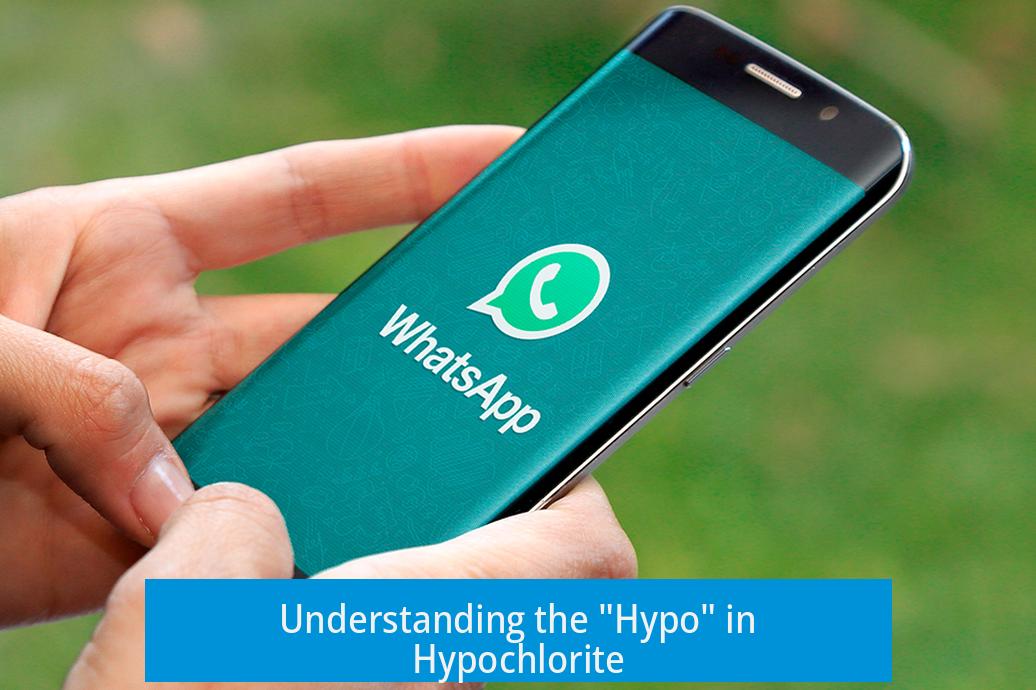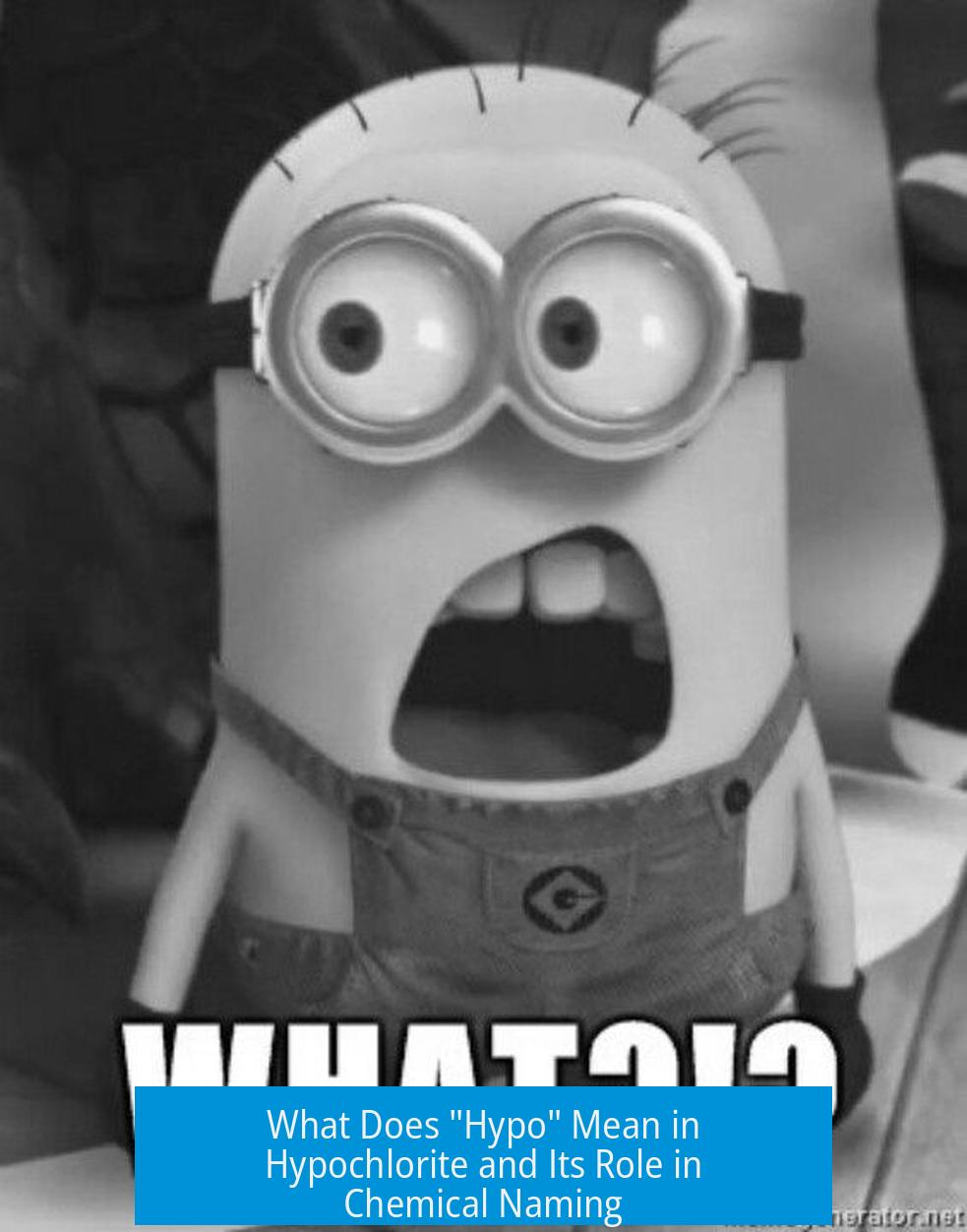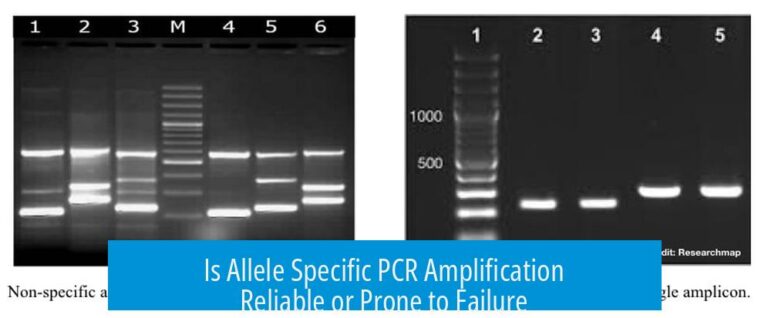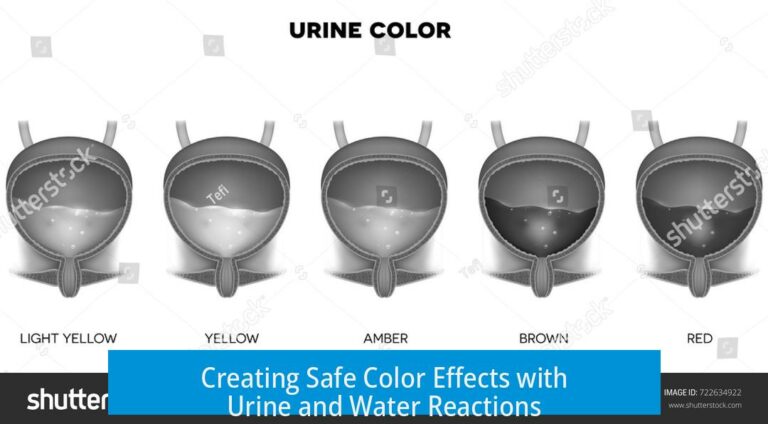Understanding the “Hypo” in Hypochlorite

The prefix “hypo” in hypochlorite indicates that chlorine is in its lowest oxidation state (+1) among related chlorine-oxygen ions, reflecting both fewer oxygen atoms and a lower oxidation number compared to chlorite, chlorate, and perchlorate ions.
Meaning of “Hypo” in Chemical Nomenclature

The prefix hypo- originates from Greek, meaning “under” or “less than.” In chemistry, it denotes an ion or compound with fewer oxygen atoms or a lower oxidation state relative to other related species.
In hypochlorite (ClO−), “hypo-” signals that this ion has less oxygen and chlorine in a less oxidized form compared to its related ions. It parallels “hypo-” in hypothermia, implying something “below” or “less.”

Oxidation States in Chlorine Oxyanions
Chlorine forms several oxoanions with varying numbers of oxygen atoms and different oxidation states. The progression goes as follows:

| Ion Name | Chemical Formula | Oxidation State of Cl | Oxygen Atoms |
|---|---|---|---|
| Hypochlorite | ClO− | +1 | 1 |
| Chlorite | ClO2− | +3 | 2 |
| Chlorate | ClO3− | +5 | 3 |
| Perchlorate | ClO4− | +7 | 4 |
Here, “hypo-” marks the species with the lowest chlorine oxidation state and minimum oxygen content.
Naming System Based on Oxygen Content

The oxyanion naming convention relates prefixes and suffixes to oxygen variation:
- -ate suffix denotes the base number of oxygen atoms (e.g., chlorate, ClO3−).
- per- … -ate prefix and suffix indicate one more oxygen than the “ate” form (perchlorate, ClO4−).
- -ite suffix indicates one fewer oxygen than the “ate” form (chlorite, ClO2−).
- hypo- … -ite combination shows one fewer oxygen than the “ite” form (hypochlorite, ClO−).
- -ide suffix is for ions without oxygen (e.g., chloride, Cl−).
This system helps predict ion formulas and oxidation states just from names.

Hypo Means Less Oxidized
“Hypo-” also implies a lower oxidation number. For hypochlorite, chlorine is at +1, less oxidized than chlorite (+3), chlorate (+5), and perchlorate (+7). This links the prefix to both oxygen count and electron status of chlorine.
Legacy Names and Exceptions
Not all “hypo-” names strictly reflect oxidation states. For example, in thiosulfate (formerly called hyposulfate), the sulfur oxidation states match sulfate’s. The prefix persists due to historical usage rather than current precise oxidation info.
This illustrates the evolution and sometimes the ambiguity of traditional chemical naming systems.
IUPAC and Modern Nomenclature
The International Union of Pure and Applied Chemistry (IUPAC) developed standardized naming to reduce ambiguities. Instead of relying on prefixes, modern nomenclature often uses explicit oxidation numbers in Roman numerals.
For example, iron compounds now are named using iron(II) or iron(III) rather than ferrous or ferric. Yet, classical names like hypochlorite remain widely used as they are descriptive and intuitive.
Summary of Key Points
- “Hypo-“ means “under” or “less than” in oxygen content and oxidation state.
- Hypochlorite (ClO−) has chlorine at oxidation state +1, the lowest among chlor-oxygen ions.
- Oxyanion naming indicates oxygen variation: per- (more oxygen), -ate (base), -ite (less), hypo- (least oxygen).
- Some hypo- names are historical legacies and may not reflect oxidation states precisely.
- IUPAC nomenclature prefers explicit oxidation numbers for clarity.
What’s up with the “hypo” in hypochlorite?
Before jumping into a chemistry rabbit hole, let’s get straight to the point: the “hypo” in hypochlorite means “under” or “less than,” indicating chlorine’s lowest oxidation state (+1) among its chlor-oxygen siblings. This prefix signals that hypochlorite holds the crown for least oxygen and lowest oxidation compared to chlorite, chlorate, and perchlorate.
Simple enough, right? But peel back the layers, and you’ll find a fascinating naming system built upon oxygen atoms, oxidation states, and a history that blends science with a pinch of legacy quirks.
Hypo: The “Under” Prefix in Chemistry — Not Just a Fancy Word
“Hypo” shows up in words like hypothermia, meaning “under temperature” (too cold). In chemistry, that same idea applies: “hypo” means “under” or “less”. In this case, less oxygen or less oxidation. That’s why hypochlorite (ClO−) comes from hypochlorous acid (HClO), the chlor-oxygen acid with the least oxidation of chlorine.
Think of these chlor-oxygens acids as a family reunion with four siblings:
- Hypochlorous acid (HClO) – lowest oxygen and oxidation (+1)
- Chlorous acid (HClO2) – mid-level (+3)
- Chloric acid (HClO3) – higher (+5)
- Perchloric acid (HClO4) – top dog with the most oxygen (+7)
See how it goes from “hypo” (under) to “per” (through or beyond), indicating increasing oxygen levels and oxidation states?
Why Does Oxidation State Matter?
Oxidation states are the chemical mood setters. They tell chemists how electrons are sharing space around atoms in a compound. Chlorine can be chill (+1) or intense (+7), and these moods impact reactivity and use.
Hypochlorite with chlorine at +1 is the least oxidized. This low oxidation state makes it a handy disinfectant, killing germs without overdoing the oxidative stress. If you use common bleach, that’s hypochlorite at work.
Oxygen Counts, Naming Conventions, and Why We End Up With Hypo-
Here’s a naming pattern puzzle:
| Prefix/Suffix | Oxygen Count | Example | Oxidation State of Cl |
|---|---|---|---|
| Per- … ate | Base + 1 | Perchlorate (ClO4−) | +7 |
| … ate | Base | Chlorate (ClO3−) | +5 |
| … ite | Base – 1 | Chlorite (ClO2−) | +3 |
| Hypo- … ite | Base – 2 | Hypochlorite (ClO−) | +1 |
The base number is the oxygen count in chlorate (3 oxygens). From there, you lose or gain oxygens with each prefix/suffix change. “Hypo” means two oxygens less than chlorate.
This naming makes life easier—until it doesn’t. IUPAC realized these traditional prefixes could confuse people or hide the real chemistry under a mess of suffixes. That’s why today you sometimes see “chlorine(I)” for hypochlorite to spotlight the oxidation state directly.
Beware the “Hypo” Trap: Chemistry vs. Wordplay
Here’s a funny side note: newcomers often read “hypochlorite” and chuckle, “Wait, is this some chemistry hypocrite?” Nope. Not a person. No drama. Just a math and oxygen count story. The “hypo” prefix works like a trusty chemical GPS, leading to the right identification of compounds—nothing shady or two-faced here.
But What About Hypo in Other Compounds?
The “hypo” prefix also sneaks into other names like sodium hyposulfate, but here history has played tricks. Despite the “hypo-” label, sulfur in hyposulfate sits at the same oxidation state as in sulfate. Because of this, chemists renamed it thiosulfate. Yet the nickname “hypo” stuck around, especially in photography circles as the fixer solution.
This quirky naming reveals that chemistry’s language can be a bit old-fashioned, carrying “hypo” even when it no longer perfectly fits oxidation stories. Enter IUPAC, with its mission to bring clarity and consistency.
The IUPAC Revolution: Clearing Up Hypo and Friends
Remember the confusion with “ferrous” and “ferric”? Similarly, “hypo” names sometimes cause kerfuffles. To avoid guesswork, IUPAC favors using clear oxidation states (like chlorine(I) or chlorine(VII)) rather than relying purely on “hypo-” or “per-” prefixes.
This modernization helps chemists speak the same language worldwide, while old-timers can still enjoy the “hypo” charm.
Putting It All Together: Why Should You Care?
Knowing the meaning behind “hypo” in hypochlorite isn’t just nerd trivia. It explains:
- Why bleach works at killing bacteria gently (low oxidation state)
- How oxygen counts help identify and predict chemical behavior
- Why some names seem confusing but follow a logical pattern
Next time you see hypochlorite on a label, you’ll know it’s the “least oxygen, least oxidized” chlor-oxygen species, vital for clean water and disinfecting homes worldwide.
Try This in Your Chemistry Exploration
Play detective with other oxyanions. Pick the base “ate” ion and explore how oxygen counts and oxidation states shift with “hypo-,” “per-,” and “-ite” endings. You’ll unravel a cool logic puzzle wrapped in chemical formulas!
For example, nitrate (NO3−) has “hypo” and “per” cousins in other elements, but their application varies slightly, keeping the chemistry enthusiast guessing and learning.
In Summary
The prefix hypo- in hypochlorite means “under” or “less than,” pointing to the chlorine’s lowest oxidation state (+1) among related chlor-oxygen ions. It symbolizes fewer oxygen atoms compared to chlorite, chlorate, and perchlorate, following a naming pattern that reflects oxidation and oxygen count. Though some legacy terms like in hyposulfate don’t follow this rule, modern chemistry prefers explicit oxidation states for clarity.
So, if you’ve ever wondered why your bleach solution is called hypochlorite and not superchlorate, now you know—it’s modesty in its chemical form. Less oxygen, less oxidation, but still mighty in action.
What does the “hypo” prefix mean in hypochlorite?
“Hypo” means “under” or “less than.” It shows the chlorine in hypochlorite is in its lowest oxidation state among chlorine oxoanions, specifically +1.
How does “hypo” relate to oxygen atoms in chlorate compounds?
In chlorate series, “ate” is the base level oxygen count. “Per-” adds one oxygen, “-ite” removes one, and “hypo-” removes two oxygens compared to “ate.” Hypochlorite has the fewest oxygens.
Why isn’t “hypo” always linked to a lower oxidation state, like in thiosulfate?
Some names with “hypo” come from old naming conventions. In thiosulfate, sulfur’s oxidation state isn’t lower, but the prefix stayed due to tradition.
How does naming with “hypo” compare to modern IUPAC standards?
IUPAC prefers using oxidation numbers directly to reduce confusion. Prefixes like “hypo” are less common now because they can be ambiguous.
What is the oxidation state of chlorine in hypochlorite compared to chlorate and perchlorate?
Chlorine in hypochlorite is +1. In chlorite it’s +3, chlorate +5, and perchlorate +7, showing increasing oxidation states as oxygen atoms are added.





Leave a Comment